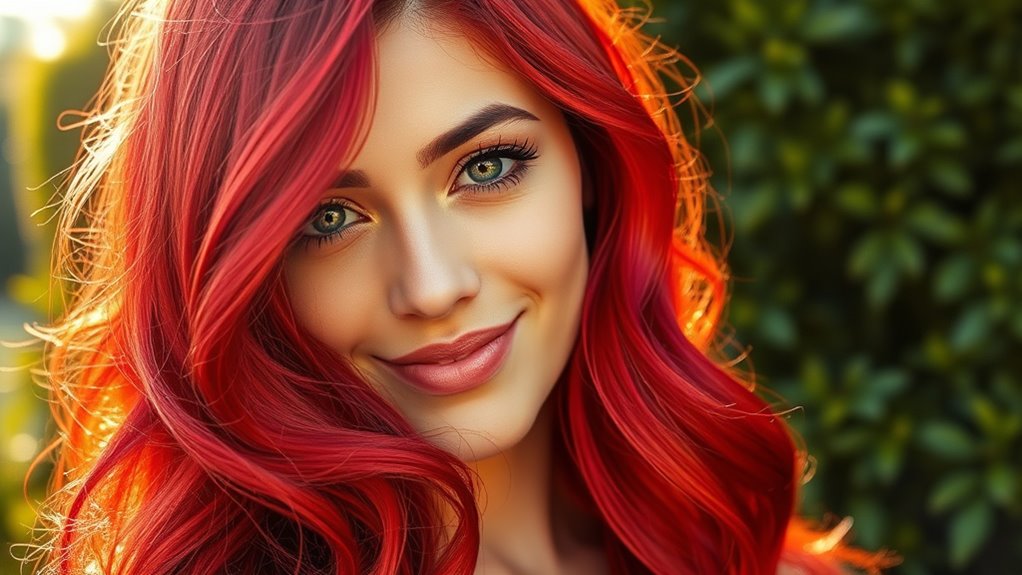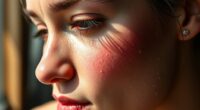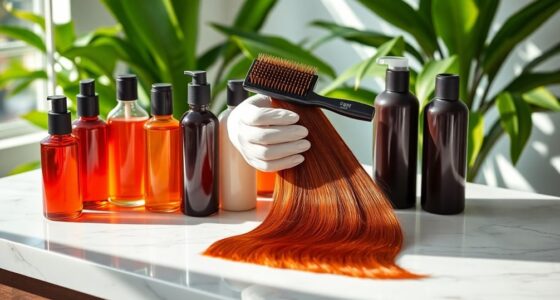To turn heads with striking red hair, start by choosing the right dye that complements your skin tone and eye color. Prepare your hair by deep conditioning and using a clarifying shampoo for even color. Use essential tools like brushes and gloves during application, ensuring to section your hair for even distribution. After coloring, maintain vibrancy with sulfate-free products and cool water rinses. Discover more techniques to keep your red hair looking fabulous!
Key Takeaways
- Choose a red shade that complements your skin tone and eye color for a striking look.
- Prepare your hair by deep conditioning and using a clarifying shampoo for better dye absorption.
- Use precise application tools like brushes and sectioning clips to ensure even coverage and prevent color bleeding.
- Maintain your vibrant color by using sulfate-free shampoos and washing your hair infrequently.
- Incorporate at-home gloss treatments to enhance vibrancy and keep your red hair looking fresh.
Choosing the Right Red Hair Dye
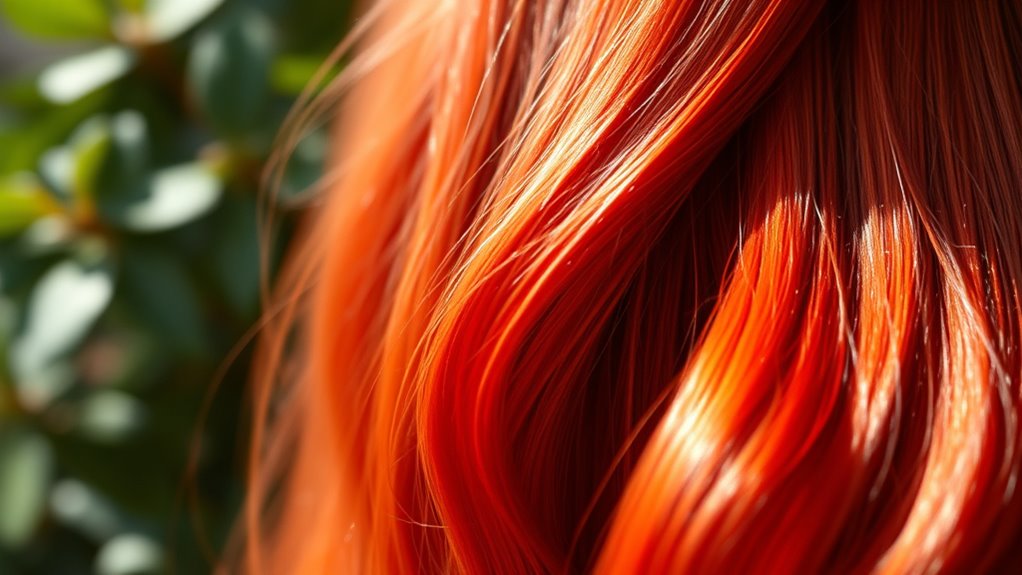
When choosing the right red hair dye, it’s essential to take into account your skin tone, natural hair color, and eye color.
If you have warm undertones, go for copper or golden reds. For cool undertones, ash red or cooler shades are best. Neutral undertones can play with a mix of both.
Fair skin often looks great with ginger or cinnamon tones, while deeper reds complement darker skin beautifully. Identifying undertones can greatly assist in selecting complementary shades of red for your hair.
Your current hair color influences how vibrant the dye appears, so consider if pre-lightening is needed.
Blue eyes pop with cool reds, while green eyes shine with warm tones.
Finally, think about seasonal color analysis; light reds suit spring, while deep reds fit winter.
Choose wisely to rock that red look!
Preparing Your Hair for Dyeing

Preparing your hair for dyeing is essential for achieving vibrant, long-lasting color. Start by deep conditioning your hair to prevent dryness, especially if you have curly locks. Additionally, be sure to avoid washing hair too close to your dye session to prevent scalp irritation.
Wash your hair three days before dyeing to remove product buildup, allowing for even color distribution. Glycolic acid can be beneficial for your scalp health, promoting a balanced environment for dye application. Avoid using any hair products in the days leading up to your dye session to guarantee your hair is free from residue.
A clarifying shampoo can help eliminate dirt and buildup, enhancing dye adhesion. Don’t forget to trim the ends to reduce frizz and brittleness.
Finally, make sure your hair is properly moisturized to maintain strength and minimize damage during the coloring process. These steps will set you up for stunning results!
Essential Application Tools

To achieve the best results when dyeing your hair, having the right application tools is essential.
Start with gloves to protect your hands from staining and guarantee a smooth application. Use bristle brushes for uniform color saturation, and combs to distribute dye evenly from roots to lengths. Parting-tips are great for precise sectioning during touch-ups. Customized tools, such as customized gloves, can significantly improve the dyeing experience by ensuring a snug and comfortable fit.
If you’re feeling adventurous, consider an automatic device like Colorsonic, which mixes and applies dye quickly and efficiently. Additional tools like coloring bowls, color tint brushes, and alligator clips can streamline the process.
Don’t forget digital timers to keep track of application time. With these tools in hand, you’ll be ready to rock that striking red hue!
Techniques for Even Color Distribution
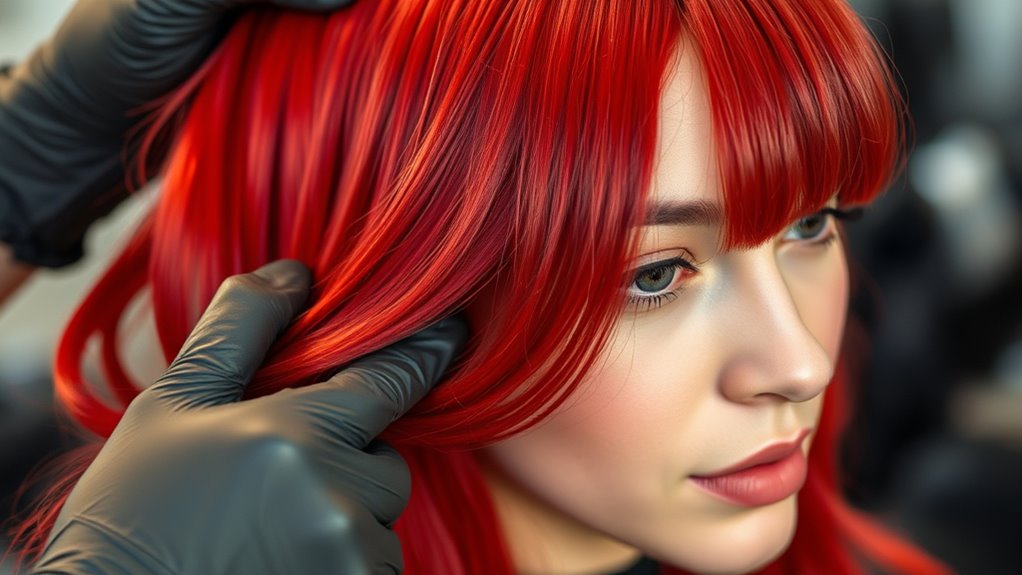
Achieving even color distribution is essential for a flawless look. Start by cleansing your hair to make sure it’s grease-free for ideal dye absorption. Section your hair into manageable parts, making application easier and preventing color bleeding. Protect your skin by applying petroleum jelly along your hairline. Before choosing your dye, check your hair’s porosity; this helps in selecting the right formulation. When applying, use a brush for precision, starting from the roots and working your way to the tips. Blend the dye thoroughly to avoid uneven tones and keep an eye on missed spots using a mirror. Finally, remember to follow the dye-to-developer ratio for consistent results. Additionally, improper sectioning may lead to missed areas and patches of color, so ensure that each section is well-defined. Your careful prep will pay off with stunning, vibrant color!
Optimal Processing Time for Vibrancy
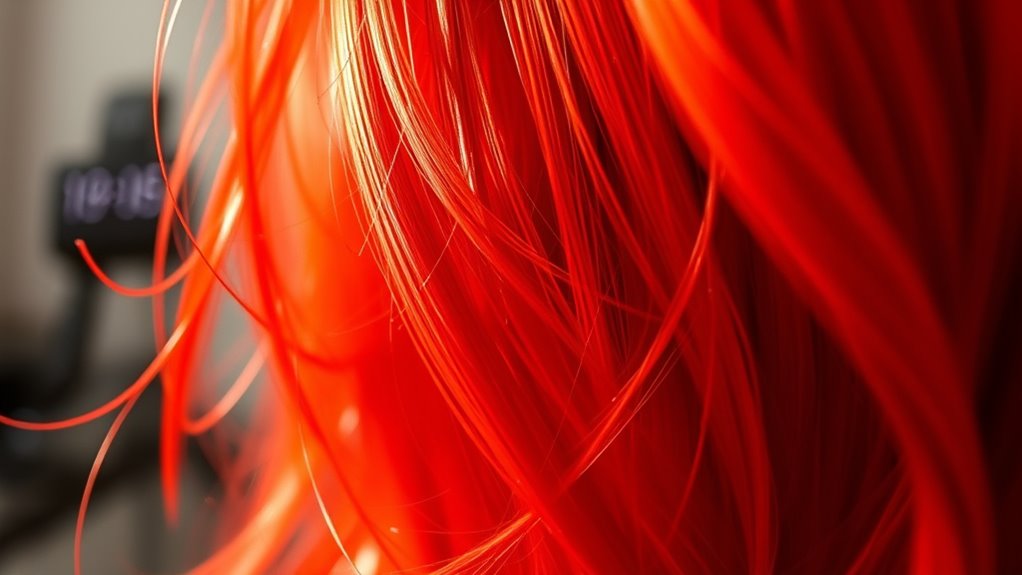
After ensuring even color distribution, the next step in your hair dye process is determining the ideal processing time for vibrancy.
For unbleached hair, aim for 30-40 minutes to achieve the best red hue. Remember, the longer you let the dye sit, the more intense the color will be, but don’t exceed the recommended time to avoid damage. Red hair dye fades faster due to larger dye molecules that do not penetrate the hair cortex deeply. Different dye brands may have varying recommendations, so always check the instructions. Environmental factors like heat and moisture can also influence how well the color sets.
Once you’re ready to rinse, do so until the water runs barely pink, ensuring you keep that vibrant color locked in without excess loss.
Tips for Maintaining Your Red Hair Color

Maintaining your vibrant red hair color requires a thoughtful approach to both products and habits.
Start by choosing ammonia-free dyes and sulfate-free shampoos that protect your color. Color-safe conditioners and UV protective products are essential for preserving vibrancy. Healthy hair retains color better and fades less, so prioritize nourishment in your hair care routine. Regularly using products rich in vitamins and nutrients can significantly improve hair health, while incorporating essential oils can further enhance scalp wellness.
Wash your hair no more than twice a week, and consider using dry shampoos to extend time between washes. Always rinse with cool water to reduce pigment loss.
Protect your hair from environmental factors by wearing hats outdoors and limiting swimming in chlorine pools.
Incorporate at-home gloss treatments and color-boosting masks to enhance vibrancy.
Finally, don’t forget to regularly touch up your roots to keep your red hair looking fresh and stunning!
Addressing Risks and Precautions

When using red hair dye, it’s crucial to be aware of potential risks and take necessary precautions to protect your health and hair.
Skin irritation and allergic reactions can occur, so perform a patch test before applying. Always follow the manufacturer’s instructions carefully, and minimize scalp contact to reduce irritation. To prevent hair damage, avoid overusing dye; give your scalp time to recover between applications. Wear gloves during application to protect your skin. Be mindful of ingredients like PPD, which can cause allergic reactions. If you experience symptoms like redness or swelling, consult a dermatologist. HC Red No. 7 is commonly used in these dyes, so understanding its effects can further enhance your safety. Staying informed and cautious guarantees a safer dyeing experience, letting you enjoy that vibrant red without unnecessary risks.
Embracing the Social Impact of Red Hair

While red hair often evokes a mix of admiration and prejudice, embracing its social impact can foster a deeper understanding of cultural nuances.
Historically, figures like Queen Elizabeth I made red hair desirable, yet stereotypes persist, often labeling redheads as deviant or overly fiery. This stigma can lead to bullying and isolation.
However, media portrayals, from celebrity influences to iconic characters, challenge these narratives, showcasing red hair as a symbol of uniqueness. Understanding the health implications associated with red hair, like increased skin cancer risk and certain risks, adds another layer to its social perception.
Frequently Asked Questions
Can I Mix Different Brands of Red Hair Dye?
Yes, you can mix different brands of red hair dye, as long as they’re the same type, like semi-permanent or vegetable dyes.
Mixing various shades can help you create a unique tone, but be cautious with dyes that contain developers.
Always check the specific instructions on the packaging and perform a patch test to avoid allergic reactions.
Conditioning your hair afterward is essential to maintain its health and vibrancy.
How Often Should I Dye My Hair Red?
If you’re dreaming of vibrant red hair that turns heads, you can’t go wild with dyeing!
Aim to refresh your color every 4-8 weeks, depending on your hair’s health and how fast it grows. Overdo it, and you risk brittle locks and split ends.
Will Red Hair Dye Work on Gray Hair?
Yes, red hair dye can work on gray hair, but you need to apply it carefully to avoid uneven color.
Choose the right shade that complements your skin tone, and consider using a permanent dye for better coverage.
Pre-treating your hair can enhance the dye’s effectiveness, while regular maintenance with color-protecting products will help keep your vibrant look.
Just remember, touch-ups will be necessary as the color can fade over time.
Can I Use Conditioner After Dyeing My Hair?
Yes, you can use conditioner after dyeing your hair, and it’s actually recommended!
Conditioner helps lock in color and keeps your hair moisturized, reducing dryness from the dye. Just make sure to apply it right after rinsing out the dye for maximum benefits.
Look for a specialized conditioner designed for colored hair, as it’ll provide added nourishment and protection.
How Can I Remove Red Hair Dye Stains From Skin?
You’ve just dyed your hair and, coincidentally, your skin’s now sporting some unwanted red stains.
Don’t worry! Grab some makeup remover or micellar water to dissolve those stubborn marks, especially around your face.
If that doesn’t work, try oil-based solutions like coconut oil, or a gentle scrub with sugar.
For tough stains, rubbing alcohol can help, but make sure to moisturize afterward.
Quick action is key to keeping your skin dye-free!
Conclusion
Now that you’re armed with the tricks to achieve that stunning red hue, it’s time to rock your new look! Did you know that red hair is the rarest natural hair color, found in only about 1-2% of the global population? Embrace the uniqueness and confidence that comes with your vibrant locks. With the right care, your red hair will turn heads and make a statement wherever you go. Get ready to shine!
